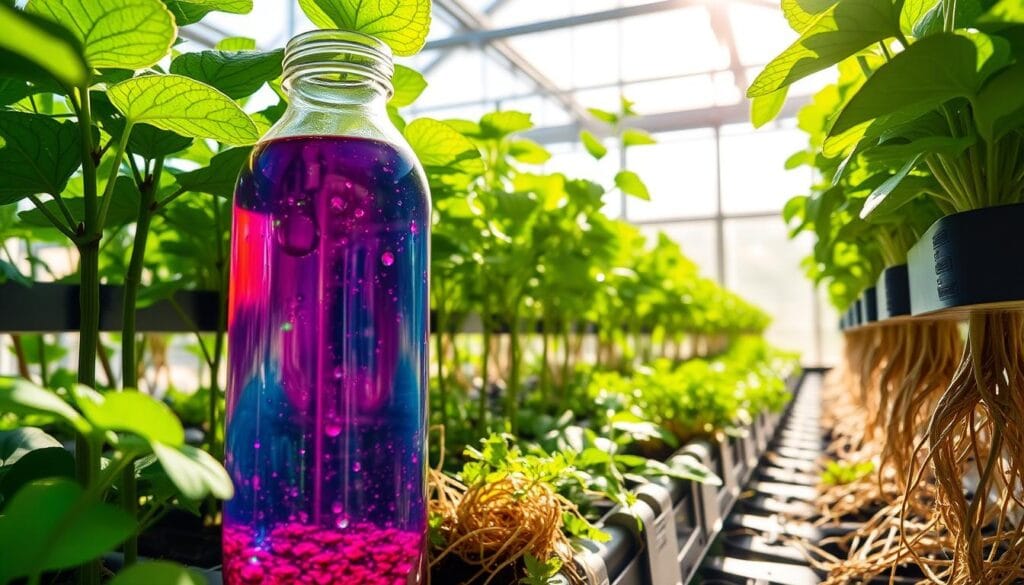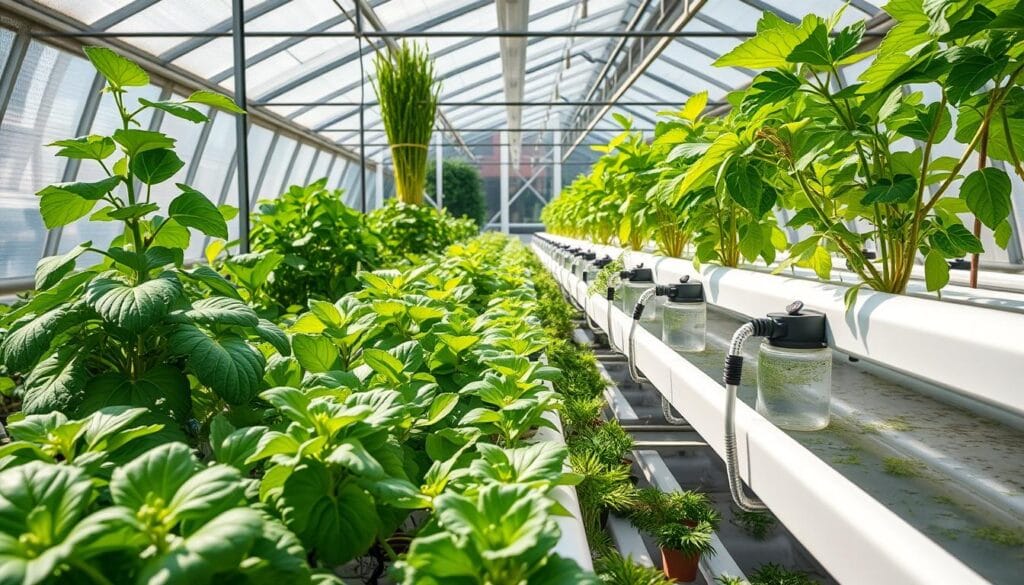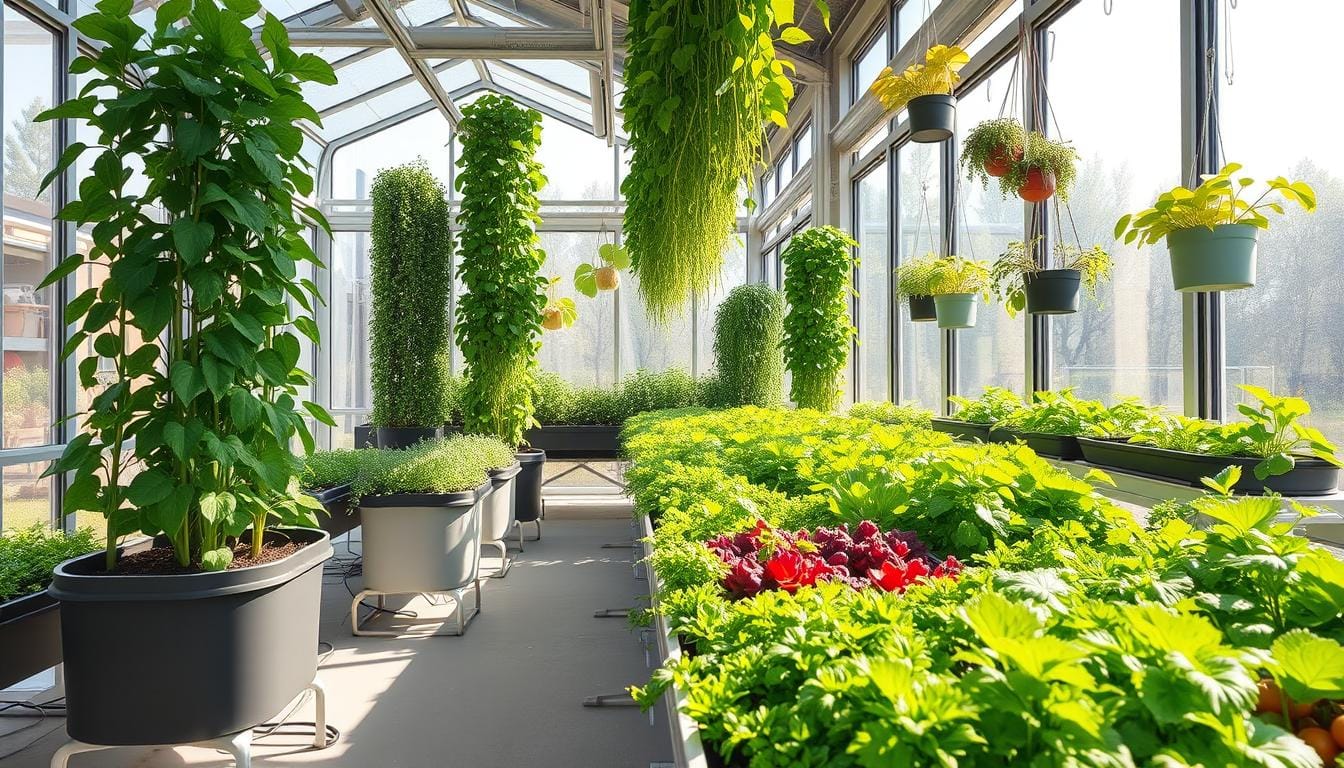A bountiful harvest is promised as the sun’s warmth touches the soil. But what if you could grow your food without traditional gardening’s limits? With DIY hydroponic greenhouse tips, you can unlock a new way to grow plants at home, even in small spaces.
Imagine a garden that grows all year, free from nature’s changes. Hydroponic systems use nutrient-rich water to feed your plants, allowing them to grow to their best. You can grow everything from leafy greens to ripe tomatoes.
In this guide, we’ll show you how to set up your DIY hydroponic greenhouse. You’ll learn to grow fresh food at home. Get ready for an exciting journey where your green thumb can shine, no matter the weather.
Key Takeaways
- Hydroponic gardening allows for efficient, year-round cultivation in small spaces.
- Hydroponic systems offer faster growth rates and higher yields compared to traditional soil-based methods.
- Proper nutrient management and water maintenance are crucial for successful hydroponic gardening.
- Certain plant varieties, such as leafy greens and herbs, thrive exceptionally well in hydroponic setups.
- Investing in redundancy and proper maintenance can help mitigate the risks of hydroponic system failures.
Understanding Hydroponic Basics for Success
Hydroponic gardening offers a modern approach to cultivating plants without the use of soil. It uses nutrient-rich solutions and a special growing medium. This method saves water, handles weather, and fights plant diseases. It’s also great for growing in cities.
What is Hydroponic Gardening?
Hydroponic gardening grows plants in a water-based solution. This method lets plants get nutrients directly through their roots. It helps plants grow faster and healthier than in soil.
Benefits of Soilless Growing
- Efficient water usage: Hydroponic systems use water wisely, saving a lot compared to traditional gardening.
- Resilience to weather conditions: Plants in hydroponic setups are protected from outdoor weather.
- Reduced plant diseases: Without soil, plants are less likely to get diseases.
- Faster growth: Plants get nutrients directly, helping them grow faster.
- Suitability for urban environments: Hydroponic systems are perfect for small spaces in cities.
Essential Components of a Hydroponic System
To operate properly, a hydroponic system needs a few important parts:
- Nutrient solution: A mix of nutrients that plants absorb through their roots.
- Growing medium: A material like a coco coir or perlite that supports and holds moisture for plants.
- Delivery system: A way to get the nutrient solution to the roots, like a pump or wick.
Keeping an eye on these parts is important. It supports plants in staying healthy and growing strong.
Choosing the Right Hydroponic System Type
Choosing the right hydroponic system is key to growing success. You have options like deep water culture (DWC), nutrient film technique (NFT), drip systems, and aeroponic setups. Each has its advantages and considerations. Knowing what each system offers helps you pick the best one for your space, budget, and goals.
Deepwater culture (DWC) is great for beginners. It consists of plants floating in a nutrient-dense solution. It’s simple and affordable, working well for both small and large gardens. Nutrient film technique (NFT) systems have a shallow stream of solution over the roots. This keeps nutrients flowing constantly.
Drip systems are perfect for those who want precision. They deliver nutrients right to the plant base. This is ideal for bigger plants and those with special watering needs.
| Hydroponic System | Key Features | Ideal for |
|---|---|---|
| Deep Water Culture (DWC) | Floating plant roots in nutrient-rich solution | Beginners, small-scale, and larger-scale hydroponics |
| Nutrient Film Technique (NFT) | Shallow stream of nutrient solution flowing over roots | Continuous nutrient supply, efficient water usage |
| Drip Systems | Direct nutrient delivery to plant base | Larger plants, specific watering requirements |
| Aeroponic Systems | Suspending roots in air, misting with nutrients | Faster plant growth, experienced gardeners |
Aeroponic systems are for the advanced gardener. They suspend roots in air and mist them with nutrients. This method boosts growth due to better oxygen levels, but it’s more complex to set up and maintain.
The right hydroponic system depends on your space, budget, crop, and experience. Knowing each system’s strengths helps you choose wisely. This choice is crucial for a successful hydroponic greenhouse.
Essential DIY Hydroponic Greenhouse Tips
To make a DIY hydroponic greenhouse work well, you need to plan carefully. You must think about your greenhouse design, climate control, and ventilation. These tips will help you grow plants indoors in a productive and green way.
Space Planning and Layout
Planning your space well is key to a good DIY hydroponic greenhouse. Use vertical gardening like tiered shelves or towers to save space. This not only grows more plants but also improves air and light for them.
Temperature Control Methods
Keeping the right temperature is vital for your plants. Try to keep it between 65°F and 75°F, which is good for many plants. Use heaters or coolers as needed to keep your plants happy.
Ventilation Requirements
Good ventilation stops humidity, mold, and disease in your greenhouse. Add fans or vents to keep air moving. Check humidity levels, which should be between 40% and 70%, to keep your plants healthy.
Follow these DIY hydroponic greenhouse tips to make a great indoor growing space. Check your greenhouse’s layout, temperature, and air often to keep it working well.
| Hydroponic System | Advantages | Disadvantages |
|---|---|---|
| Nutrient Film Technique (NFT) | Saves water and nutrients | Roots may dry out due to air exposure |
| Ebb and Flow | Suitable for various plants | Complex system with high dependency on electricity |
| Wick System | Low cost and simple operation | Not suitable for high-water plants |
| Deep Water Culture (DWC) | Simple, easy to maintain, promotes rapid growth | Needs continuous power supply, additional support for larger plants |
The DWC system is great for indoor hydroponics because it’s simple, efficient, and works well for many plants.
Mastering Nutrient Solutions and Water Management
Nutrient solutions are key in hydroponic systems, giving plants the nutrients they need to grow. It’s important to get the NPK ratio (nitrogen, phosphorus, and potassium) right for each growth stage. Look for the NPK ratio on pre-made hydroponic fertilizers to find the best one for your plants.
Micro-nutrients like calcium, magnesium, and iron are also crucial for plant health. Keeping an eye on pH levels (5.5-6.5) and nutrient concentrations helps plants absorb nutrients well. This prevents problems like stunted growth or yellow leaves.
The water quality in your hydroponic system is very important. Use clean, filtered water to give your plants the best nutrients. A system for recycling and replenishing the nutrient solution helps keep plants healthy and reduces waste.
By learning how to manage nutrient solutions and water quality, you can create a lush hydroponic garden. Keep an eye on things, make adjustments when needed, and watch your plants thrive. The right mix of hydroponic fertilizers, pH balance, EC levels, and water quality is key.

“Effective nutrient management forms the basis of a successful hydroponic garden. Invest the time to understand your plants’ needs, and you’ll be rewarded with a bountiful harvest.”
Selecting Ideal Plants for Your Hydroponic Setup
Starting your hydroponic garden is exciting. The first step is choosing the right plants. Whether you’re new or experienced, knowing which plants work well in hydroponics opens up new possibilities.
Best Plants for Beginners
Beginners should start with leafy greens like lettuce, spinach, and kale. These hydroponic vegetables grow fast and need little space. Basil, cilantro, and mint are also great options for hydroponic gardening. They grow quickly and need little care.
Growth Cycles and Expectations
It’s important to know how long plants take to grow. Fast-growing plants like greens and herbs are ready in 25-45 days. High-yield crops like tomatoes and peppers take 60-130 days. This helps you plan when to harvest and manage your garden.
Plant Spacing Guidelines
Proper plant spacing is essential for a successful hydroponic garden. Give each plant enough room for roots and leaves. This ensures they get the nutrients and air they need without crowding. The exact spacing depends on the plant, but a good rule is 6-12 inches for small plants and 3-5 feet for larger ones.
“Hydroponic gardening allows you to grow a wide variety of plants, from leafy greens to fruiting vegetables, with remarkable speed and efficiency.”
Lighting Solutions for Year-Round Growth
LED grow lights are key for indoor hydroponic gardening. They give plants the light spectrum they need to grow well. These lights offer the right mix of photoperiod and artificial lighting for strong plant growth.
Place your LED grow lights 12-16 inches above your plants. This keeps leaves and stems safe from burning. Use timers to set the light cycle. This is usually 14-16 hours for growing and 12 hours for flowering.
Even with a greenhouse, LED grow lights can make a big difference. They offer steady, reliable light for the best growth. Their energy-saving design and adjustable light spectrums help you get great harvests all year.
| Light Spectrum | Wavelength Range | Plant Benefit |
|---|---|---|
| Blue Light | 425 to 450 nanometers | Supports plant development and growth |
| Red Light | 600 to 700 nanometers | Promotes flowering and fruit production |
Choosing and placing your LED grow lights wisely creates the best light for your hydroponic garden. This ensures your plants are healthy and your harvests are plentiful, all year round.
Monitoring and Maintaining System Health
Keeping your hydroponic system healthy is all about regular monitoring. It’s important to manage pH levels and prevent diseases. These steps help your plants grow well.
pH Level Management
It’s vital to keep the pH between 5.5 and 6.5 for your plants to absorb nutrients well. Regularly check the water using a pH meter. Adjust it with pH-up or pH-down solutions when necessary. This way, your plants will thrive.
Disease Prevention Strategies
Good disease prevention is key for system hygiene and plant health monitoring. Clean your equipment often, ensure good air flow, and don’t overwater. If pests show up, use organic pest control to protect your garden.
Regular Maintenance Schedule
Having a regular maintenance routine is crucial. Clean pumps, filters, and reservoirs to avoid clogs and ensure water flows well. Check your plants for stress or disease signs often. Fix any problems quickly. This way, you’ll have a healthy and productive hydroponic harvest.
| Maintenance Task | Frequency |
|---|---|
| Clean Reservoir | Weekly |
| Inspect & Clean Filters | Monthly |
| Check pH & Nutrient Levels | Daily |
| Inspect Plants for Pests/Disease | Weekly |
| Clean Pump & Tubing | Quarterly |
“Consistent monitoring and maintenance are the cornerstones of a thriving hydroponic system. By staying on top of these crucial tasks, you’ll ensure your plants receive the optimal growing conditions for a bountiful harvest.”
Common Pitfalls to Avoid in Hydroponic Growing
Starting a hydroponic garden can be very rewarding. But, it’s important to avoid common problems. Issues like nutrient imbalances, light burn, and root rot can harm your garden. Knowing about these problems helps keep your garden healthy.
Nutrient imbalances are a big problem. Too much food for your plants can cause damage. It’s important to get the right mix of nutrients like nitrogen, phosphorus, and potassium.
Plants can experience light burn if they receive too much light. Make sure your plants are the right distance from the light. This helps them grow well.
- Leafy greens, tomatoes, and strawberries are great for beginners.
- Root vegetables like potatoes, onions, and carrots need soil to grow well in hydroponics.
Root rot is another issue. It can kill your plants if not stopped. Make sure your water is moving and your roots have enough air.
Algae growth can also be a problem. Keep your nutrient solution away from light to stop algae. This keeps your system clean and healthy.
Finally, pH fluctuations can stress your plants. Check and adjust your system’s pH often. This helps your plants grow well.
By watching out for these problems, you can have a successful hydroponic garden. With the right knowledge, you can overcome these challenges. Enjoy the benefits of growing without soil.

Budget-Friendly Equipment and Tools
Starting your hydroponic garden doesn’t have to cost a lot. You can save money by choosing the right equipment and using smart strategies. This way, you can have a great DIY hydroponic greenhouse without spending too much.
Essential Tools List
Here are the main tools you need for a hydroponic garden:
- pH and EC (electrical conductivity) meters to check your nutrient solution
- Measuring cups and spoons for accurate nutrient mixing
- Trimming scissors to keep your plants in shape
- A thermometer and hygrometer to watch temperature and humidity
Cost-Saving Tips
To save money on your hydroponic garden, try these tips:
- Begin with a basic setup like Deep Water Culture before getting more complex systems.
- Choose energy-saving LED grow lights to cut down on electricity bills.
- Use recycled materials, like old plastic containers, for your water reservoirs. Make sure they’re safe for food and chemicals.
- Look for DIY hydroponic equipment and affordable grow lights at hardware stores or online. Check for sales during off-peak seasons.
- Use recycled materials to build your greenhouse. Look for old windows, doors, and frames.
By following these tips, you can grow a successful hydroponic garden without spending a lot. You can still have a high-quality garden without breaking the bank.
Conclusion
It’s a green and resource-efficient way to cultivate plants through hydroponics. It’s perfect for city farming, growing plants all year, and getting more from small spaces. Learning the basics, picking the right system, and caring for your plants are key to success.
This method is a big step towards better farming and food safety everywhere. It’s great for beginners and experts alike. You can choose from systems like Nutrient Film Technique (NFT) for small plants or Deep Water Culture (DWC) for bigger ones.
The hydroponics market is growing fast, showing the future of farming is green. By using hydroponics, you help make food production better for the planet. You’ll also enjoy a rich harvest in your own greenhouse. Start your journey to a greener future with hydroponic gardening.

